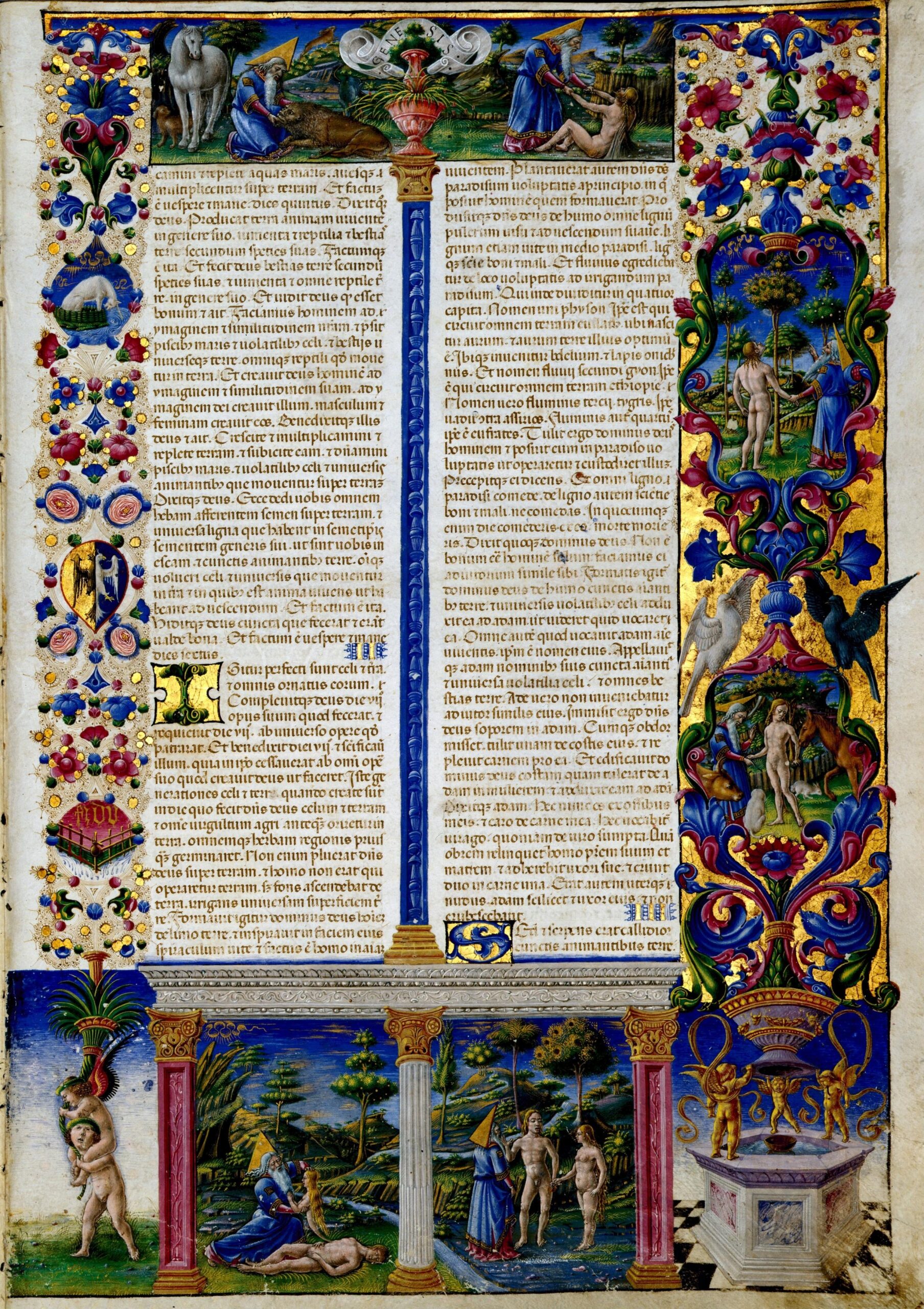The Bible was commissioned by Borso d’Este just after the middle of the 15th century, and is considered the most valuable miniated manuscript in Italy. A team of artists, led by the miniaturists Taddeo Crivelli and Franco dei Russi who were entrusted with its execution, worked day and night with the help of a large number of assistants. Borso in fact wanted a magnificent work that would give fame and lustre to the Este family, but in addition to precision, he also demanded speed of execution. Borso used art as a tool to transform his policy of magnificence and exaltation of the House of Este into something visible and tangible. From the fresco cycle of Schifanoia to the Bible, the work of art was necessary to show a value, a characteristic or a purpose that celebrated the Este family. The importance of the Bible is underlined by the contract, dated 11 July 1455, that Borso signed with the two main artists, which provided for the decoration of a Bible in a special format and divided into two volumes: the timing, the remuneration and certain details of the decoration were established. In addition, Crivelli and dei Russi were provided with a home in which to live and work. The work was carefully monitored by the commissioner to whom all pages were submitted for final approval. After the first three years of work, the contract was revised with stricter conditions: the quantity of work to be delivered each month was established and, only for dei Russi, a sanction was envisaged if the delivery was not respected. According to the contract, the manuscript was completed in six years, from 1455 to 1461: 600 illuminated parchment pages on both sides for a total of 1202 pages. The manuscript cost Borso 5610 Marchesan lire, including parchment, writing, miniatures, stitching, gilding of the fascicles, the wooden case for its preservation, the cloth cover embroidered with gold threads and the silver clasps. The attention to the work of the miniaturists and the overall cost that Borso was willing to pay for the work demonstrate the firm desire to create what is considered a masterpiece of the Renaissance, which, then as now, exalts the House of Este. Borso knew he possessed a masterpiece, in fact, as well as showing it to ambassadors and sovereigns visiting Ferrara, he took it with him to Rome in 1471 when he received the much-desired ducal title over Ferrara from Pope Paul II.
The Bible became a symbol of the greatness achieved by the family and this importance had to be visually translated with images expressing the gestures, deeds and highest qualities of the Este family. The decoration of marginal friezes is rich in ‘feats’ that are the visual representation, often hermetic in its meaning, of a purpose, behaviour, desire or conduct. They are adopted by rulers to make themselves known, associating their name with particular events or characteristics, also to distinguish themselves in fame and importance from their predecessors. The feat is often completed by a motto that with a few words helps to understand the deliberately enigmatic meaning of the image.
The decoration does not remain relegated to miniated initials alone, but develops within friezes where it finds a continuous narrative in vignettes and medallions between emblems, feats, putti, inscriptions, real and imaginary animals, flora and vegetation; all elements that refer to the Este power evoked by the representations of water, the countryside and hunting.
In 1598, following the Devolution of Ferrara, the Bible followed the Este family to Modena. The fear of spoliation caused by Napoleon’s invasion caused the work to be transferred to Vienna where the Este family was in exile and returned to Modena in 1831 with Francesco IV of Austria-Este. The last Duke of Modena Francesco V took it back to Vienna when he left the duchy’s territories forever in 1859. Here the Bible was inherited by Archduke Ferdinand, Francesco Giuseppe and finally by Charles I, whose wife Zita sold it on the Paris antiques market. After an initial transfer of ownership, it was recovered in 1923 and purchased at auction in Paris by Senator Giovanni Treccani for the astronomical sum of almost 5,000,000 lire. Treccani returned it to the Italian State in 1925, donating it to the Biblioteca Estense in Modena, where it is still kept today.
It is now possible to admire and consult this priceless Renaissance masterpiece directly at home with just a few clicks thanks to the important work of digitisation carried out by the Estense Digital Library.
Click on the link to access the browsable version of the Estense Digital Library: https://edl.beniculturali.it/open/3015932
Persistent identifier Bible of Borso d’Este https://n2t.net/ark:/65666/v1/16178 and https://n2t.net/ark:/65666/v1/16179







